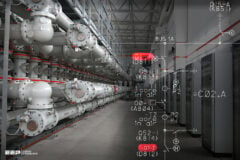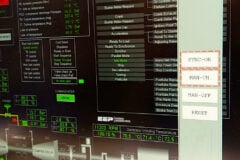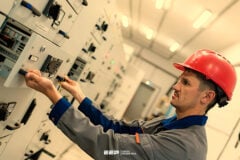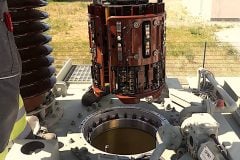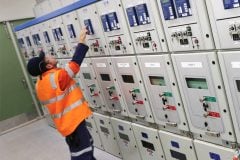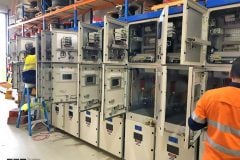Modifications of MV/LV radial systems
This technical article covers low voltage and medium radial distribution systems with their practical modifications: loop-primary system – radial secondary, primary selective system – secondary radial and two-source primary – secondary selective system.
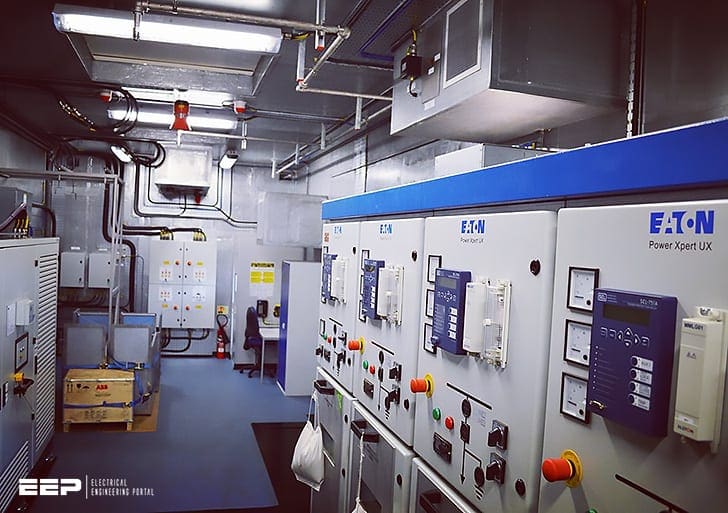
This discussion covers the last three modifications of radial distribution systems. Previous technical article covered simple low voltage and medium radial distribution systems.
If you didn’t read the first part, you can read it here.
- Simple low voltage radial system
- Simple medium voltage radial system
- Loop-primary system – radial secondary system
- Primary selective system – secondary radial system
- Two-source primary – secondary selective system
3. Loop primary system – Radial secondary system
This system consists of one or more primary loops with two or more transformers connected on the loop. This system is typically most effective when two services are available from the utility as shown in Figure 1.
When pad-mounted compartmentalized transformers are used, they are furnished with loop-feed oil-immersed gang-operated load-break sectionalizing switches and Bay-O-Net expulsion fuses in series with partial range back-up current-limiting fuses.


When secondary unit substations are used, each transformer may have its own:
- Duplex sectionalizing switches ((2-load break switches with load side bus connection)) and primary load break fused switch as shown in Figure 2(a) or
- Utilizing three on-off switches (Figure 2b) or a 4-position sectionalizing switch and
- Vacuum fault interrupter (VFI) internal to the transformer saving cost and reducing footprint (Figure 2c).


By operating the appropriate sectionalizing switches, it is possible to disconnect any section of the loop conductors from the rest of the system.
In addition, it is possible to disconnect any transformer from the loop.


A key interlocking scheme is normally recommended to prevent closing all sectionalizing devices in the loop. Each primary loop sectionalizing switch and the feeder breakers to the loop are interlocked such that to be closed they require a key (which is held captive until the switch or breaker is opened) and one less key than the number of key interlock cylinders is furnished.
An extra key is provided to defeat the interlock under qualified supervision.
For slightly added cost, an automatic throw-over scheme can be added between the two main breakers and tie breaker. During the more common event of a utility outage, the automatic transfer scheme provides significantly reduced power outage time.
The system in Figure 1 has higher costs than in Figure 4 (explained in previous article), but offers increased reliability and quick restoration of service when:
- Utility outage occurs,
- Primary feeder conductor fault occurs, or
- Transformer fault or overload occurs.
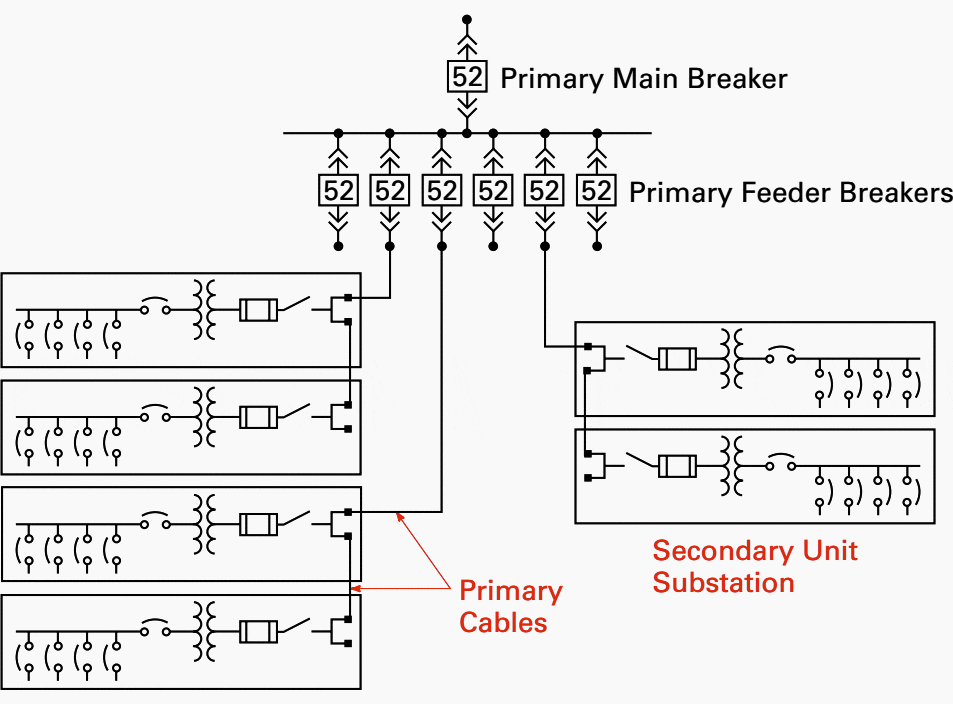

Should a utility outage occur on one of the incoming lines, the associated primary main breaker is opened and the tie breaker closed either manually or through an automatic transfer scheme. When a primary feeder conductor fault occurs, the associated loop feeder breaker opens and interrupts service to all loads up to the normally open primary loop load break switch (typically half of the loads).
Once it is determined which section of primary cable has been faulted, the loop sectionalizing switches on each side of the faulted conductor can be opened, the loop sectionalizing switch that had been previously left open can then be closed to all secondary unit substations while the faulted conductor is replaced.
If the fault should occur in a conductor directly on the load side of one of the loop feeder breakers, the loop feeder breaker is kept open after tripping and the next load side loop sectionalizing switch manually opened so that the faulted conductor can be sectionalized and replaced.
Increasing the number of primary loops will reduce the extent of the outage from a conductor fault, but will also increase the system investment.
When a transformer fault or overload occurs, the transformer primary fuses open, and the transformer primary switch manually opened, disconnecting the transformer from the loop, and leaving all other secondary unit substation loads unaffected.
A basic primary loop system that uses a single primary feeder breaker connected directly to two loop feeder switches which in turn then feed the loop is shown in Figure 5.


In this basic system, the loop may be normally operated with one of the loop sectionalizing switches open is described above or with all loop sectionalizing switches closed.
If a fault occurs in the basic primary loop system, the single loop feeder breaker trips, and secondary loads are lost until the faulted conductor is found and eliminated from the loop by opening the appropriate loop sectionalizing switches and then reclosing the breaker.
4. Primary Selective System – Secondary Radial System
The primary selective—secondary radial system, as shown in Figure 6, differs from those previously described in that it employs at least two primary feeder circuits in each load area.
It is designed so that when one primary circuit is out of service, the remaining feeder or feeders have sufficient capacity to carry the total load. Half of the transformers are normally connected to each of the two feeders.
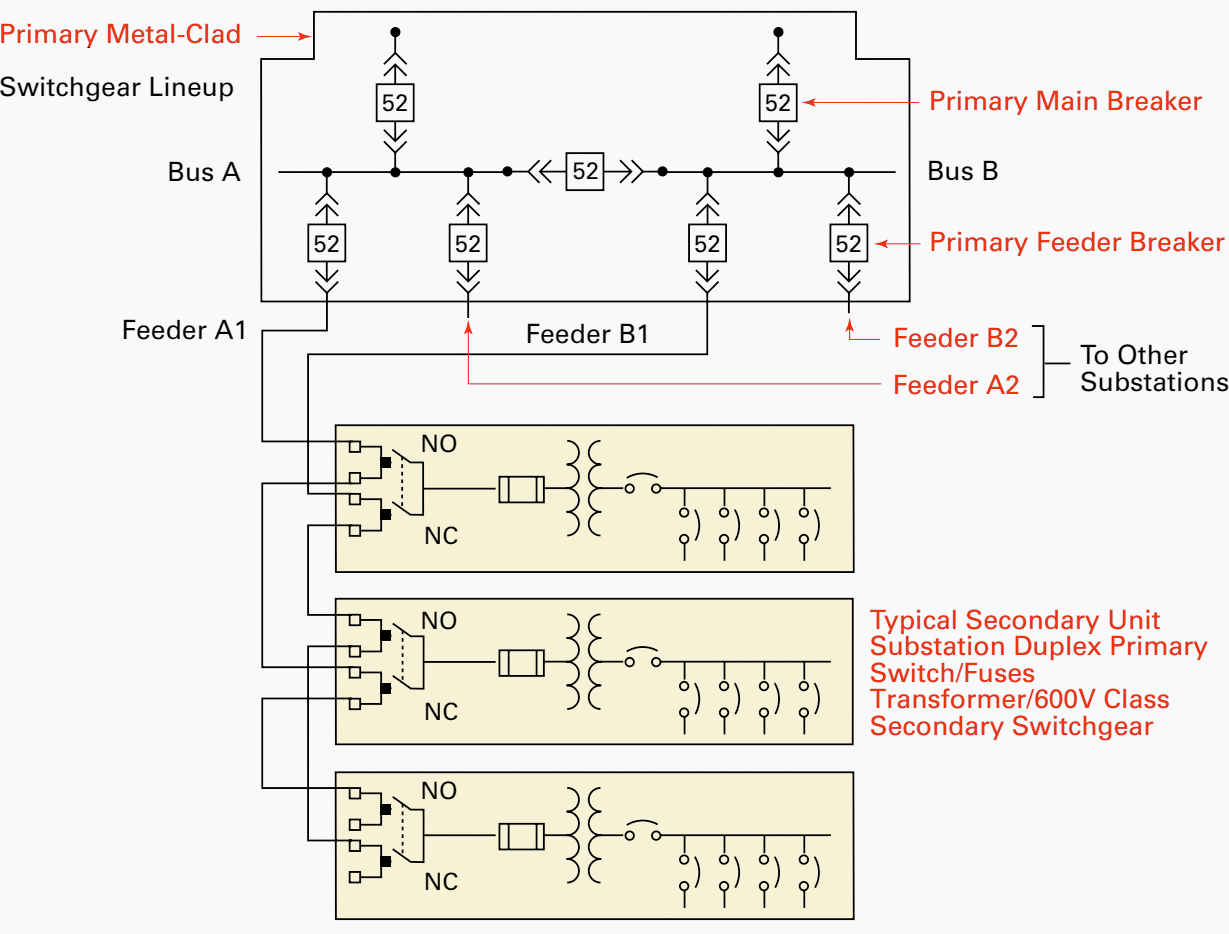

When a fault occurs on one of the primary feeders, only half of the load in the building is dropped.
Duplex fused switches as shown in Figure 6 and detailed in Figure 7 may be utilized for this type of system. Each duplex fused switch consists of two load break three-pole switches each in their own separate structure, connected together by busbars on the load side.
Typically, the load break switch closest to the transformer includes a fuse assembly with fuses.


Mechanical and/or key interlocking is furnished such that both switches cannot be closed at the same time (to prevent parallel operation) and interlocking such that access to either switch or fuse assembly cannot be obtained unless both switches are opened.
The non-load break selector switch is physically located in the rear of the load break fused switch, thus only requiring one structure and a lower cost and floor space savings over the duplex arrangement. The non-load break switch is mechanically interlocked to prevent its operation unless the load break switch is opened.
The main disadvantage of the selector switch is that conductors from both circuits are terminated in the same structure.


This means limited cable space especially if double lugs are furnished for each line as shown in Figure 6. The downside is that should a faulted primary conductor have to be changed, both lines would have to be de-energized for safe changing of the faulted conductors.
A second alternative is utilizing a three-position selector switch internal to the transformer, allowing only one primary feeder to be connected to the transformer at a time without the need for any interlocking. The selector switch is rated for load-breaking.
If overcurrent protection is also required, a vacuum fault interrupter (VFI), also internal to the transformer, may be utilized, reducing floor space.
In Figure 6 when a primary feeder fault occurs, the associated feeder breaker opens and the transformers normally supplied from the faulted feeder are out of service. Then manually, each primary switch connected to the faulted line must be opened and then the alternate line primary switch can be closed connecting the transformer to the live feeder, thus restoring service to all loads.
Note that each of the primary circuit conductors for Feeder A1 and B1 must be sized to handle the sum of the loads normally connected to both A1 and B1. Similar sizing of Feeders A2 and B2, etc., is required.
If a fault occurs in one transformer, the associated primary fuses blow and interrupt the service to just the load served by that transformer. Service cannot be restored to the loads normally served by the faulted transformer until the transformer is repaired or replaced.
The benefits from the reduction in the amount of load lost when a primary feeder is faulted, plus the quick restoration of service to all or most of the loads, may more than offset the greater cost.
Having two sources allows for either manual or automatic transfer of the two primary main breakers and tie breaker should one of the sources become unavailable.
The primary selective-secondary radial system, however, may be less costly or more costly than a primary loop – secondary radial system of Figure 1 depending on the physical location of the transformers.
It also offers comparable downtime and reliability. The cost of conductors for the types of systems may vary depending on the location of the transformers and loads within the facility. The cost differences of the conductors may offset cost of the primary switching equipment.
5. Two-Source Primary – Secondary Selective System
This system uses the same principle of duplicate sources from the power supply point using two primary main breakers and a primary tie breaker.
Each transformer secondary is arranged in a typical double-ended unit substation arrangement as shown in Figure 9.
The two secondary main breakers and secondary tie breaker of each unit substation are again either mechanically or electrically interlocked to prevent parallel operation. Upon loss of secondary source voltage on one side, manual or automatic transfer may be used to transfer the loads to the other side, thus restoring power to all secondary loads.


This arrangement permits quick restoration of service to all loads when a primary feeder or transformer fault occurs by opening the associated secondary main and closing the secondary tie breaker.
If the loss of secondary voltage has occurred because of a primary feeder fault with the associated primary feeder breaker opening, then all secondary loads normally served by the faulted feeder would have to be transferred to the opposite primary feeder.
This means each primary feeder conductor must be sized to carry the load on both sides of all the secondary buses it is serving under secondary emergency transfer.
In either of the above emergency conditions, the in-service transformer of a double-ended unit substation would have to have the capability of serving the loads on both sides of the tie breaker. For
this reason, transformers used in this application must have equal kVA ratings on each side of the double-ended unit substation. The transformers are sized so the normal operating maximum load on each transformer is typically about 2/3 base nameplate kVA rating.
Typically these transformers are furnished with fan-cooling and/or lower than normal temperature rise such that under emergency conditions they can continuously carry the maximum load on both sides of the secondary tie breaker.
Because of this spare transformer capacity, the voltage regulation provided by the double-ended unit substation system under normal conditions is better than that of the systems previously discussed.
The double-ended unit substation arrangement can be used in conjunction with any of the previous systems discussed, which involve two primary sources. Although not recommended, if allowed by the utility, momentary re-transfer of loads to the restored source may be made closed transition (anti-parallel interlock schemes would have to be defeated) for either the primary or secondary systems.
Under this condition, all equipment interrupting and momentary ratings should be suitable for the fault current available from both sources.
For double-ended unit substations equipped with ground fault systems special consideration to transformer neutral grounding and equipment operation should be made. Where two single-ended unit substations are connected together by busway or external tie conductors, it is recommended that a tie breaker be furnished at each end of the tie conductors.
The second tie breaker provides a means to isolate the interconnection between the two single-ended substations for maintenance or servicing purposes.
Source: Power system design basics – Eaton

